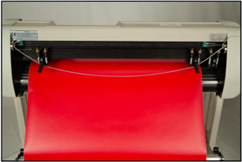
It strikes seemingly at random. A formerly well behaved vinyl cutter goes wild, turning off mid-job, or sinking its blade into a roll of vinyl and running long inscrutable cut-lines, devouring yards of precious material.
Your first impulse is to call the Ghostbusters, but the poltergeists seem to only be haunting your vinyl cutter. Your second impulse is to call the business who sold you this strange object and find out how to get your money back. The ruined vinyl is probably a lost cause.
The likely culprit, says one of our helpful support techs, is not malevolent sprites that have been making the hair stand up on your arm pretty much since you unpacked that roll of vinyl from the plastic…but static.
To diagnose static interference with your value vinyl cutter, our support staff recommends you remove the blade and vinyl and run your job a few times. If your machine works fine, then try adding the vinyl back in, and run the job again. If the spooky phenomena repeats, our support tech will be pretty confident we’re dealing with an invisible, but fundamentally reasonable, and not supernatural opponent.
Vinyl is an insulator which freely gives away positive-charged ions to any surface it rubs against. Itself, the carpet, the plastic it comes in, and your vinyl cutter. As vinyl rolls through your machine, these ions build up in the cutter, and if they aren’t dissipated somehow, they will build up to such a point that they discharge as electricity, causing interference in the electronics of your vinyl cutter.
Certain atmospheric conditions make this more likely, namely low humidity. So a cutter that works fine can suddenly start experiencing static issues due to a change in seasons. In the winter when it’s cold and the moisture literally freezes out of the air, a cutter that’s been working fine all summer can suddenly fall victim to static. Similarly, a cutter in a desert area might work fine in the winter but go haywire as soon as the thermometer starts to rise.
USCutter has a few helpful tips and some products which can solve static problems. First off is the grounding cable which probably came with your cutter. This wire attaches from a screw at the base of your cutter to a screw on the stand (you can also use copper or speaker wire). It is important that the stripped wire ends make metal to metal contact so it might be necessary to strip some paint away on your stand. This basically makes the cutter think it’s bigger and there is more room for the charge to build up.

Another major culprit for new vinyl cutters seemingly going haywire is the included software. Sure Cuts A Lot Pro must be registered using the keycode on the back of the disc package, otherwise the software assumes that it’s in “trial version” mode, and will make random cuts in addition to cutting your design.
If these easy solves don’t work, for less than $15 USCutter offers:
 A piece of specially fabricated static string is literally draped across your vinyl as it rolls through the machine. Secured by magnets at either end of the cutter housing, this string dissipates the static charge.
A piece of specially fabricated static string is literally draped across your vinyl as it rolls through the machine. Secured by magnets at either end of the cutter housing, this string dissipates the static charge.
Some of our customers swear by using an anti-static spray, or wiping their vinyl down with dryer sheets, or running a humidifier in the immediate vicinity of the cutter. In addition, most office supply stores stock anti-static mats (they can be a little pricey – one that fits under a 28” cutter can run as high as $150 with shipping).
If all else fails, we call in the Exorcist.
In the case of our SC and Laserpoint vinyl cutters it is most times advisable to “super-ground” your motherboard and rollers into the wall socket. The above pdf link explains and depicts how this is achieved.
USCutter hopes that this blog entry has been a helpful, reassuring and demystifying experience for you and your vinyl cutter. Stay tuned for more postings aimed at the beginning- and professional-level graphics-makers out there!